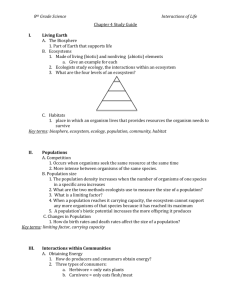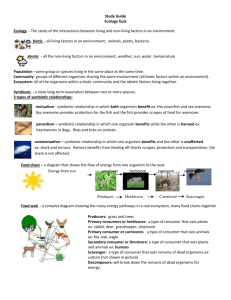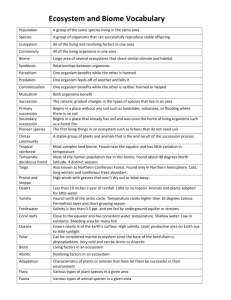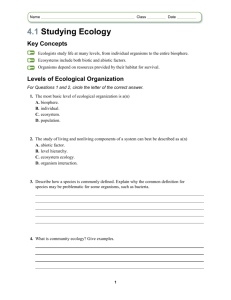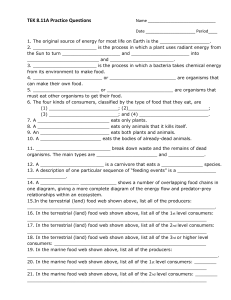Vocabulary/Homework 2/18-2/28
advertisement
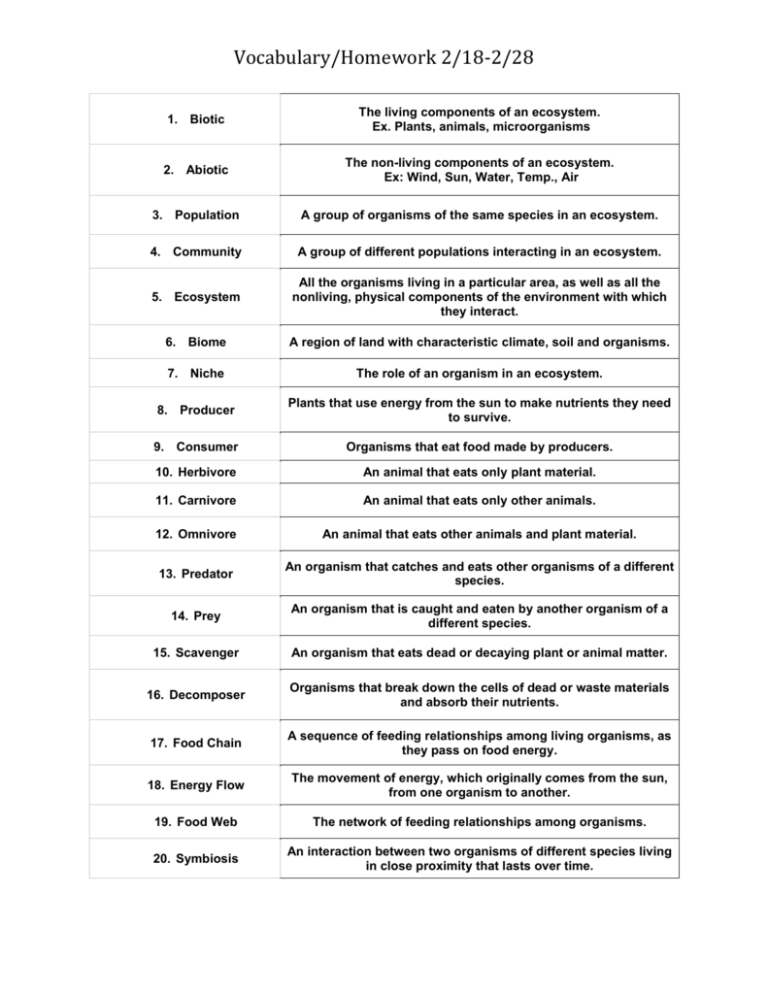
Vocabulary/Homework 2/18-2/28 1. Biotic The living components of an ecosystem. Ex. Plants, animals, microorganisms 2. Abiotic The non-living components of an ecosystem. Ex: Wind, Sun, Water, Temp., Air 3. Population A group of organisms of the same species in an ecosystem. 4. Community A group of different populations interacting in an ecosystem. 5. Ecosystem All the organisms living in a particular area, as well as all the nonliving, physical components of the environment with which they interact. 6. Biome A region of land with characteristic climate, soil and organisms. 7. Niche The role of an organism in an ecosystem. 8. Producer Plants that use energy from the sun to make nutrients they need to survive. 9. Consumer Organisms that eat food made by producers. 10. Herbivore An animal that eats only plant material. 11. Carnivore An animal that eats only other animals. 12. Omnivore An animal that eats other animals and plant material. 13. Predator An organism that catches and eats other organisms of a different species. 14. Prey An organism that is caught and eaten by another organism of a different species. 15. Scavenger An organism that eats dead or decaying plant or animal matter. 16. Decomposer Organisms that break down the cells of dead or waste materials and absorb their nutrients. 17. Food Chain A sequence of feeding relationships among living organisms, as they pass on food energy. 18. Energy Flow The movement of energy, which originally comes from the sun, from one organism to another. 19. Food Web The network of feeding relationships among organisms. 20. Symbiosis An interaction between two organisms of different species living in close proximity that lasts over time. Vocabulary/Homework 2/18-2/28 21. Parasitism A symbiotic relationship in which one of the partners is harmed and the other benefits. 22. Mutualism A symbiotic relationship in which both partners benefit. 23. Commensalism A symbiotic relationship in which one partner benefits and the other is indifferent. 24. Energy Pyramid A pyramid showing the number of organisms at each level of a food chain. 25. Succession The process by which new species gradually replace old species in an ecosystem. Tuesday, 2/18: Make flashcards for vocabulary 1-12 and Vocab Wheel (definition, use word in a sentence, illustration) Wednesday, 2/19: Make flashcards for vocabulary 13- 25 and Vocab Wheel (definition, use word in a sentence, illustration) Thursday, 2/20 Draw an ecosystem with 7 biotic factors and 7 abiotic factors on lineless paper. Must include a “Key”. Monday, 2/24 Create a terrestrial and an aquatic food web with 3 food chains and 4 levels. Tuesday, 2/25 Make a foldable title “Three Types of Symbiotic Relationships” (mutualism, parasitism, commensalism) must include definition, two examples, and colorful illustrations on lineless paper. Wednesday, 2/26 Create a poem using 12 vocabulary words with a colorful illustration. No line paper. Thursday, 2/27 “Biome” Divide your lineless paper in half. Select one biome to illustrate on the top portion. On the bottom portion, describe the biome including ecosystems, populations, habitats, abiotic factors, biotic factors, temperature, climate, symbiotic relationships. This activity will be started in class and finished for homework.
